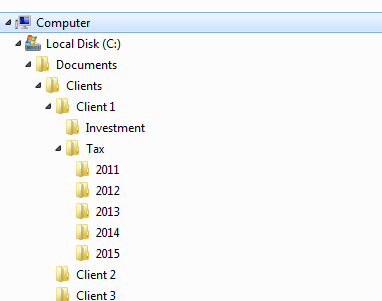Remember the ubiquitous file shares which end up as the central document repository for many organizations. This document repository becomes crucial for the business as it stores all the important business documents required by the employees to do their day-to-day job. This document repository is typically based on the file folder structure and the folder names in this structure act as the metadata for the documents in that folder.
A classic example of the file share would be where a firm keeps their client documents with one folder for each client, (client 1, client 2, client 3), each client folder containing sub folders for each service being provided to the client (investment, tax) and then each service folder containing the client documents under each year of service (2011, 2012, 2013, 2014, 2015) etc. (See below)

There are several limitations with the use of the file share as the central document repository especially when the file share grows beyond a threshold.
- There is no search in the file share unless the user knows the exact file name they are looking for. Security on the individual folders or documents become a nightmare to manage.
- Several clicks in the deep file folder structure are required to navigate to the required document.
We have helped many clients with the migration of their file share to SharePoint to leverage all the document management features and help the organization to get rid of file share altogether. There are multiple third party tools available to help with file share migrations into SharePoint.
Keep the following scenarios in mind to help you have a successful file share migration:
- Do not duplicate the folder structure in SharePoint. You will continue to face the limitations of the file share under SharePoint as well with this folder structure. SharePoint works well with the metadata on the documents.
- The folder names must be used as the metadata for the documents being saved in SharePoint. Also, this will enable the organization to leverage the document management functionality in SharePoint. The following metadata cab be captured easily:
- Client 1, client 2 and client 3 can be captured as the, “client ID” metadata
- Tax, investments can be captured as the, “service ID” metadata
- 2011, 2012, etc. can be captured as the, “year of service,” metadata
- There are file attributes (Creation date, modified date, author, name etc.) which are captured in SharePoint automatically
- The file share must be analyzed for all the huge files and must be filtered out from migration. During the life cycle of using this file share, the organizations dump their huge back up files in the file shares. These files are not good to store in SharePoint and these files will cause a significant delay in your overall file share migration.
- The server containing the file share must be available 100% during the migration. If there is a backup job scheduled during the migration it will significantly slow down the process.
- All the scheduled jobs on the file share must be disabled during the migration. The scheduled jobs include the anti-virus service, reboot service, backup service etc. If any of these scheduled jobs kick in during the migration, it will significantly slow down the process and sometime it causes the termination of the file share migration altogether due to the timeouts from the file shares and SharePoint.
- File share grows over several years without any monitoring and will always have files which are not required for the business going forward and can be archived/deleted/cleaned up during the migration to SharePoint.
- There are several file types which are not supported by Office web apps in SharePoint and the browser will not know how to open those files. A plan to handle those file types should be analyzed and created before migrating all these files.
- Security on the file share can block the access of certain files while migrating them to SharePoint. The tool used to migrate the file share must be run under an admin account who has access to all the files without getting blocked by the individual permissions set on the folder and/or files.
- Files with the same names get overwritten in SharePoint if they are being migrated to the same document library. A quick analysis of all the file names in all the folders must be done to make sure that duplicate file names do not exist specially when these files will be migrated to the same document library in SharePoint.
To find out more about this or other ways that RSM can assist you with your SharePoint needs, contact RSM’s technology consulting professionals at 800.274.3978 or email us.

 RSMUS.com
RSMUS.com